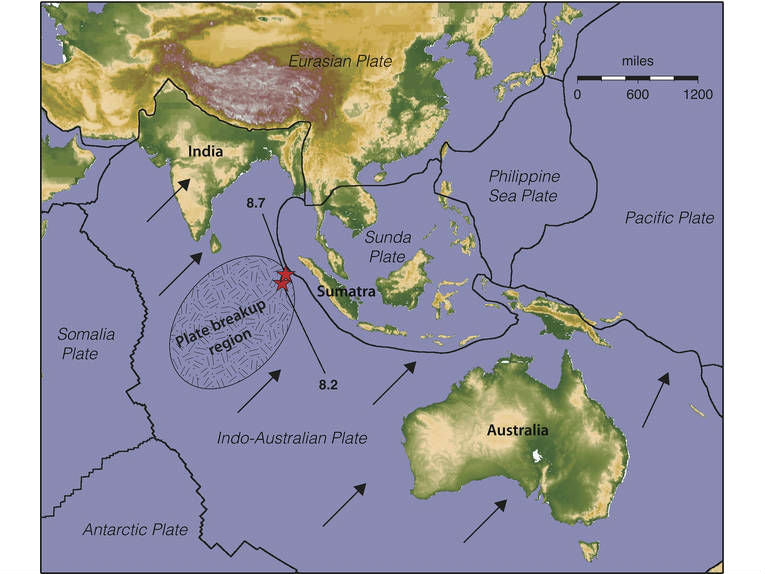Possibly the largest earthquake of its kind has been recorded in the Indian Ocean, say seismologists.
At least four faults in the Indo-Australian plate caused a magnitude-8.7 earthquake in April last year, say experts from the University of Utah and University of California, Santa Cruz.
The quake was previously believed to be of 8.6 magnitude, 40% smaller than the latest estimate, the scientists have reported in the Nature journal.
It happened when at least four undersea fault ruptured southwest of Sumatra, Indonesia, in less than three minutes. At least 10 people died from the quake or resulting heart attacks. The effects were felt from India to Australia, including South and Southeast Asia.
Taken as separate quakes, the magnitude of the ruptures would have been 8.5, 7.9, 8.3 and 7.8 on the "moment magnitude" scale that calculates the largest quakes, the seismologists say.
The most powerful 8.7 shock broke three parallel offset faults called en echelon faults and a fourth fault that crossed the first fault.
The new report says the magnitude-8.7 quake and an 8.2 quake two hours after were part of the breakup of the Indian and Australian sub plates underneath the Indian Ocean - a process that began around 50 million years ago and that will last millions more.
Co-author Keith Koper, associate professor geophysics and director of the University of Utah Seismograph Stations, says, "We've never seen an earthquake like this. This is part of the messy business of breaking up a plate. This is a geologic process. It will take millions of years to form a new plate boundary and, most likely, it will take thousands of similar large quakes for that to happen."
All five faults were strike-slip faults, where ground on one side moves horizontally past ground on the other side.
It is possibly the largest strike-slip earthquake ever seismically recorded, the report says, although there was a similar sized quake in Tibet in 1950 where the type is unknown.
The study was led by graduate student Han Yue and Thorne Lay, a professor of Earth and planetary sciences, who are both from the University of California, Santa Cruz. It was financed by The National Science Foundation.
The 8.7 quake "is probably the largest intraplate [within a single tectonic plate of Earth's crust] ever seismically recorded," say Koper, Lay, Yue and Koper. The majority of earthquakes occur at plate boundaries.
The researchers cannot be sure the great quake was the largest intraplate or strike-slip quake because "we are comparing it against historic earthquakes long before we had modern seismometers," says Koper.
The quakes were probably triggered by alterations in crustal stresses caused by the magnitude-9.1 Sumatra-Andaman earthquake of Boxing Day, 2004, which caused huge tsunamis that killed most of the 228,000 victims in the Indian Ocean area, says Koper.
As the 8.7 and 8.2 quakes were caused by horizontal movements of seafloor strike-slip faults, not vertical movement along thrust faults, they only caused small tsunamis up to one foot in height that was measured at Meulaboh, Indonesia, by U.S. Geological Survey.
Koper says as there were no significant tsunamis, the great earthquake caused "very little damage and death, especially for this size of an earthquake, because it happened in the ocean and away from coastlines," and on strike-slip faults.
The quake was studied through a variety of methods to examine the seismic waves generated. As the data can be interpreted in different ways, Koper says it is possible that five or six fault segments broke during the 8.7 quake.
The Indo-Australian plate is breaking into two or three pieces and the magnitude-8.7 and 8.2 quakes happened over a large area where the India and Australian sub plates are being torn apart.
"What we're seeing here is the Indo-Australian plate fragmenting into two separate plates,"
The northeast-moving Indo-Australian plate is breaking because it is hitting with Asia in the northwest, slowing down the western part of the plate, while the eastern part moves more easily by diving or "subducting" below the island of Sumatra in the northeast. The subduction zone near Sumatra caused the 2004 magnitude-9.1 quake and tsunami.
Seismic data shows the recent quakes "involve rupture of a very complex network of faults, for which we have no documented precedent in recorded seismic history," according to the researchers.










